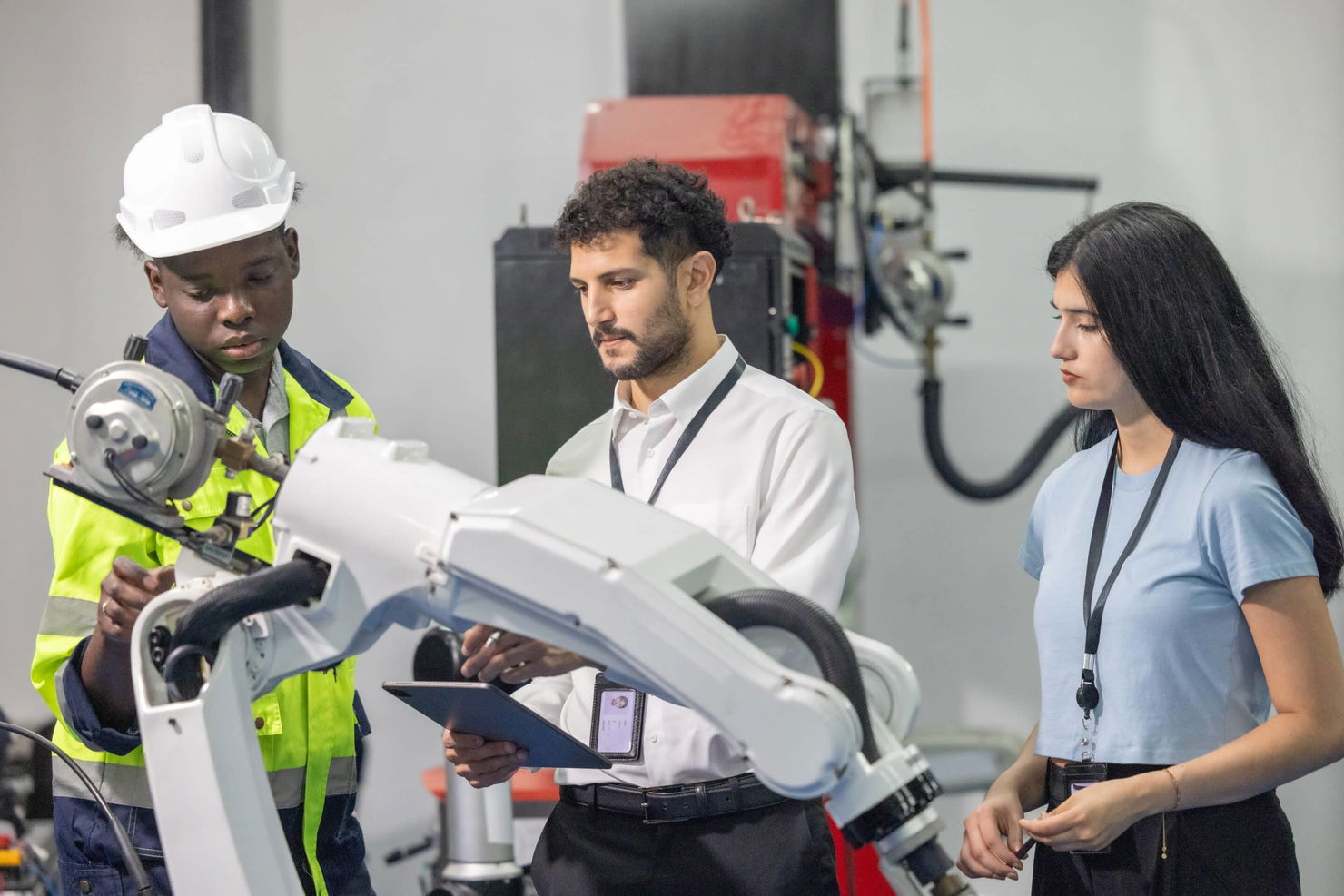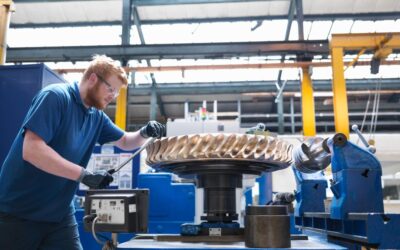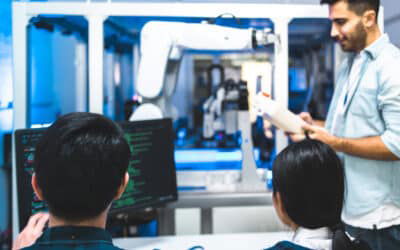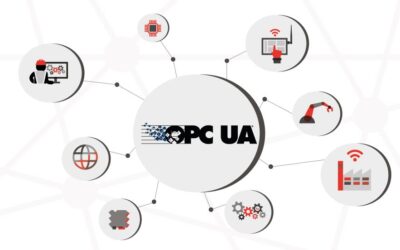In 65 years, OEE industrie 4.0 measurement has evolved from paper-based clipboards to AI-powered digital twins. This isn’t incremental progressit’s a fundamental redefinition of what “measuring manufacturing performance” means in 2025, directly impacting production efficiency across global operations.
While global average OEE stagnates at 55-60% according to Evocon’s study of 3,500+ machines, factories equipped with Industry 4.0 IoT and AI solutions achieve 75-85% a 20-30 point difference in efficiency. McKinsey documents that companies adopting Industry 4.0 realize 20-30% productivity gains and 30-50% maintenance cost reductions.
What changed? Five successive technological revolutions transformed a static indicator into a real-time predictive and prescriptive tool. This is the story of 65 years of innovation, from Nakajima’s Toyota factory to today’s smart factories and how TEEPTRAK is leading the European Industry 4.0 transformation with 120+ industrial groups, 400 factories, and 2,500+ connected production lines across 30 countries.
Era 1 (1960-1990): The Birth of OEE Concept and Manual Data Collection
Toyota’s Innovation in Performance Measurement
In 1971, Seiichi Nakajima created the OEE (Overall Equipment Effectiveness) concept as part of TPM (Total Productive Maintenance) at Toyota. The objective: measure the six major production losses and improve manufacturing process efficiency through continuous improvement.
The original six big losses affecting production efficiency:
- Equipment failures and breakdowns (equipment availability)
- Setup and changeover times (equipment availability)
- Small stops and idling (machine performance)
- Reduced speed (machine performance)
- Startup defects (quality rate)
- Production defects (quality rate)
These components form the foundation of OEE metrics: Availability × Performance × Quality = OEE Score
Tools and process: Operators used mechanical stopwatches, pre-printed paper sheets, and manual click counters. The typical process involved logging downtime in notebooks, with shift supervisors compiling data at shift end and foremen calculating weekly OEE on Mondays. Graphs were posted on shop floor boards, with monthly improvement meetings.
Documented limitations: 1-week latency between events and data analysis, 70-80% accuracy due to transcription errors, micro-stops under 5 minutes never captured (masking inefficiencies), and 2-3 hours daily per line spent on manual data entry. Average OEE score: 40-50% in 1970s-80s automotive manufacturing process.
Era 2 (1990-2010): Basic Computerization and Infrastructure Development
SCADA and MES Emergence for Production Data Management
The 1990s saw the rise of SCADA systems (Supervisory Control and Data Acquisition) and early MES (Manufacturing Execution Systems). Siemens, Rockwell, and Schneider developed proprietary solutions to improve production processes and business operations.
Key technologies and infrastructure: Programmable logic controllers (PLCs) with digital outputs, relational databases (Oracle, SQL Server), Windows graphical interfaces, and industrial Ethernet networks connected machinery across the factory floor.
Typical architecture: Machine → PLC → Local SCADA → Factory Server → Database → Daily Reports
Advances in Production Efficiency and Performance Tracking
Semi-automatic data collection enabled automated piece counting via photoelectric sensors (improving quality control), machine state detection through PLC signals (better equipment availability), automatic event timestamping (enhanced accuracy), and downtime reason entry on shop floor terminals (supporting continuous improvement).
Automated calculation included OEE formulas programmed in MES, automatic daily report generation, multi-week trend charts, and Excel exports for additional analysis.
Measured gains: Collection time reduced 60% (3h to 1h/day), accuracy improved to 85-90%, latency dropped to daily vs weekly reports, and average OEE increased from 50% to 60-65%.
Persistent limitations: No real-time data (available next day), invisible micro-stops (detection threshold >30 seconds), data silos (no ERP/PLM integration), and 6-12 months implementation time. As one European automotive Production Director noted in 2008: “We had computerized data collection, but not decision-making.”
Era 3 (2010-2020): First IoT Sensors and Real-Time Data Analysis
The Autonomous Sensor Revolution Enabling Performance and Quality Monitoring
Cloud Computing (AWS 2006, Azure 2010) and IoT protocols (MQTT 2013, LoRaWAN 2015) democratized connected solutions. Technological innovations included wireless sensors with 3-5 year battery life, lightweight protocols (MQTT, CoAP, LoRa), industrial cloud platforms (AWS IoT, Azure IoT Hub), and real-time web dashboards accessible via mobile.
New players emerged: Evocon (2012, Estonia), Worximity (2016, Canada), MachineMetrics (2013, USA), and TEEPTRAk (2014, France). The value proposition: installation under 1 day (vs 6-12 months), native real-time capability (< 1 second latency), and mobile-first interfaces. TEEPTRAk’s founding vision was making Industry 4.0 accessible to European SMEs with plug-and-play installation in under 1 hour, compatible with 100% of industrial equipment.
Market adoption: Global industrial IoT market grew from $2B (2012) to $77B (2020), 28% CAGR (McKinsey). Client results included HKScan (+20% OEE in 6 months), Nutriset with TEEPTRAk (+11% OEE over 8 years eliminating 3-4 second micro-stops occurring 50-100 times/shift), and General Electric (-10% maintenance costs via predictive monitoring). IoT early adopters achieved 70-75% OEE vs 60-65% for traditional MES solutions.
Era 3 limitations remained: No intelligence (detection without prediction), reactive alerts (after failure, not before), descriptive only (“what happened?” not “what will happen?”), and manual correlation analysis.
Era 4 (2020-2025): AI Revolution for Productivity Optimization
2020 marks Edge AI arrival: computing and artificial intelligence capabilities migrate directly into industrial equipment, reducing latency from seconds to milliseconds. Converging technologies include Edge Computing (Nvidia Jetson, AWS Greengrass), Embedded Machine Learning (TensorFlow Lite, PyTorch Mobile), Industrial 5G (< 10ms latency), and Computer Vision for real-time quality defect detection.
TEEPTRAK’s Implementation Strategies: Complete Industry 4.0 Stack
TEEPTRAK’s 2020-2025 evolution illustrates Era 4 capabilities across 120+ industrial groups, 400 factories, 2,500+ production lines in 30 countries. Implementation strategies minimize disruption while maximizing production efficiency gains through four integrated layers: multi-protocol acquisition (OPC UA, direct PLC, proprietary IoT sensors), edge computing (V3 tablets with local processing and autonomous operation), cloud analytics (ML for anomaly detection, unlimited data history, API integrations), and intelligent interfaces (adaptive dashboards, contextual alerts, AI recommendations).
1. Self-Calibrating Intelligent Sensors
TEEPTRAK’s multi-protocol approach:
- OPC UA (launched January 2024): IEC 62541 standard, universal interoperability
- Direct PLC signals: 0-24V, Modbus, Profinet
- Proprietary IoT sensors: Bluetooth, LoRa, WiFi with 3-5 year battery life
Concrete innovation: Sensors automatically adjust parameters based on environment, learning the normal profile of EACH specific machine.
Client result – Groupe Hutchinson (polymers): Philippe Devaux, Industrial Process Director, reports +10 to 15 OEE points gained with fast, participative installation freeing operators from paper documentation.
2. Machine Learning for Anomaly Detection
TEEPTRAk’s ML platform (launched 2023): Autonomous Machine Learning platform at a price 10-15x lower than custom AI projects, with 2 algorithms:
- Automatic anomaly detection
- Process optimization
Real-world pattern detection:
- Week N-4: Performance drops from 98% to 96% (imperceptible to humans)
- Week N-3: Micro-stops +15% (ML detects trend)
- Week N-2: Quality decreases 99% → 97% (defects increase)
- Week N-1: ML predicts bearing failure at 78% probability
- Action: Preventive maintenance scheduled, avoiding breakdown
Client result – Nutriset (agri-food): Sylvain Clausse, EIA Coordinator, confirms +11% OEE over 8 years by eliminating “irritants”—those 3-4 second micro-stops occurring 50-100 times per shift that escaped manual detection entirely.
3. Predictive Maintenance Based on OEE Patterns
McKinsey ROI (2024):
- 20-40% increase in machine lifespan
- 30-50% downtime reduction
- 10-20% maintenance cost reduction
- 4-10% EBITDA margin improvement
Pharmaceutical case : Shift from reactive maintenance (37% OEE) to predictive (60% OEE) = $14-16M annual gain.
TEEPTRAK’s predictive approach: The system correlates OEE degradation with future failures, triggering preventive alerts before breakdowns occur.
4. Technical Architecture: OPC UA + Edge + Cloud
TEEPTRAk’s modern Industry 4.0 stack:
Layer 1: Multi-protocol acquisition
- OPC UA (since January 2024): Universal plug-and-play
- Direct PLC: 0-24V, Modbus, Profinet
- Proprietary sensors: Bluetooth, LoRa, WiFi IoT
Layer 2: Edge Computing
- V3 Touchscreen Tablets (launched 2024): Android, local processing
- Pre-processing: Filtering, aggregation, outlier detection
- Resilience: Autonomous operation if network down
Layer 3: Cloud Analytics
- Machine Learning: Anomaly detection, process optimization
- Data Lake: Unlimited history for continuous learning
- APIs: ERP, BI, third-party MES integration
Layer 4: Intelligent Interfaces
- Adaptive dashboards: Interface adjusts to user profile
- Contextual alerts: Only relevant notifications
- AI recommendations: “Here are your 3 priority actions”
Client result – PSA Stellantis (Caen factory): Christophe Pasquet, Monozukuri, confirms systems are already profitable with considerable time freed for operators who focus on production rather than paperwork.
5. OPC UA: The Game-Changing Standard
Before OPC UA: Each machine manufacturer had proprietary protocol
- Siemens S7 vs Rockwell ControlLogix vs Schneider Modicon
- Integration = custom development per machine
- Cost = €5-15k per machine type
With OPC UA:
- Universal standard: 1 protocol for all machines
- Plug & Play: < 1h connection without development
- Native security: Encryption, authentication
Industry adoption: 75%+ of new industrial equipment supports OPC UA natively (2024 vs 20% in 2018).
TEEPTRAK’s OPC UA integration (January 2024) enables seamless connection to any modern equipment, eliminating custom integration costs.
The TEEPTRAK Advantage: Industry 4.0 at SME Speed and Price
While traditional MES solutions require 6-12 months implementation and €200-500k investments, TEEPTRAk delivers Era 4 capabilities with Era 3 accessibility: installation in under 1 hour per machine, immediate real-time visibility, and ROI achieved in under 6 months.
Why TEEPTRAk Clients Achieve 75-85% OEE (vs 55-60% Industry Average)
1. Complete visibility: 100% of micro-stops captured (vs 0% manual, 50% basic MES)
2. Instant implementation: Productive from day one (vs 6-12 months traditional MES downtime)
3. Predictive intelligence: ML-powered maintenance prevents failures before they occur
4. Universal compatibility: OPC UA + multi-protocol support connects to any equipment, any age
5. Proven results: 120+ industrial groups, 400 factories, 2,500+ lines across 30 countries
Real Client Results with TEEPTRAK
Manufacturing gains achieved:
- OEE improvement: +10 to +30 points depending on starting baseline
- Production capacity: +15-25% without capital equipment investment
- Maintenance optimization: -30% unplanned downtime (McKinsey benchmark)
- Quality improvement: -50% defect rates through real-time detection
- Labor productivity: Operators freed from manual data collection
Typical implementation timeline:
- Week 1: Installation and connection (< 1 hour per machine)
- Week 2-4: Team training and system optimization
- Month 2: First measurable OEE improvements visible
- Month 3-6: Full ROI achieved through productivity gains
Frequently Asked Questions
What is the industry standard for OEE?
The industry standard for OEE is generally accepted to be 85%, representing world-class performance with minimal equipment downtime, optimal production speed, and high-quality output. However, Evocon’s study of 3,500+ machines reveals that only 6% of manufacturers achieve 85%+, with the global average at 55-60%. Industry 4.0 technologies (IoT + AI) enable companies to achieve 75-85% OEE through real-time data analysis, predictive maintenance, and automated quality control.
What are the Industry 4.0 standards?
Industry 4.0 standards include:
- Interoperability: OPC UA (IEC 62541) for universal machine communication
- Real-time capability: Edge computing with minimal latency
- Decentralization: Autonomous decision-making at equipment level
- Information transparency: Digital twins and complete data visibility
- Technical assistance: AI-powered recommendations and predictive analytics
- Cybersecurity: Encrypted data transmission and authentication protocols
These standards enable smart factories with seamless communication between machines, devices, and humans, leveraging IoT and AI for continuous improvement and production efficiency.
What's a good OEE score?
A good OEE score depends on industry and maturity level:
- Under 60%: Below average, significant improvement opportunities
- 60-75%: Acceptable for traditional manufacturing, room for improvement
- 75-85%: Good performance, approaching world-class
- 85%+: World-class excellence (achieved by only 6% of manufacturers)
By sector (verified data):
- Pharmaceutical: 35-37% average, 70% world-class
- Food & Beverage: 70-80% average, 80-85% leaders
- Automotive: 75% average, 84-86% lean factories
- Electronics: 80-83% average, 85%+ leaders
Companies using Industry 4.0 IoT and AI solutions achieve 75-85% OEE versus 55-60% with manual methodsa 20-30 point difference.
Conclusion: OEE as the Industrial Nervous System
In 65 years, OEE evolved from a retrospective indicator (“what happened?”) to a predictive and prescriptive nervous system (“what will happen and what should we do?”).
Three Major Transformations
1. Temporality: Weekly → Daily → Real-time → Predictive
2. Intelligence: Descriptive → Diagnostic → Predictive → Prescriptive
3. Accessibility: Enterprise-only → Mid-market → SME democratization
The 2025 Imperative
The numbers speak:
- OEE gap: 55-60% (manual) versus 75-85% (IoT+AI) represents 20-30 points of untapped capacity
- Only 6% of manufacturers achieve World Class 85%+ (Evocon study, 3,500+ machines)
- Companies adopting Industry 4.0 realize 20-30% productivity gains (McKinsey)
The question is no longer “Should we digitalize?” but “How much longer can we afford to wait?”
Your Next Steps
1. Assess your digital maturity
- Era 1-2 (manual/basic MES): Critical gap, urgent action needed
- Era 3 (basic IoT): AI/ML opportunity to reach next level
- Era 4 (IoT+AI): Continuous optimization, Era 5 preparation
2. Calculate your personalized ROI Our calculator estimates your potential gains based on current configuration.
→ Calculate My ROI
3. See Era 4 in action 20-minute demonstration: OPC UA, Edge ML, predictive maintenance on your use cases.
→ Book My Demo





0 Comments